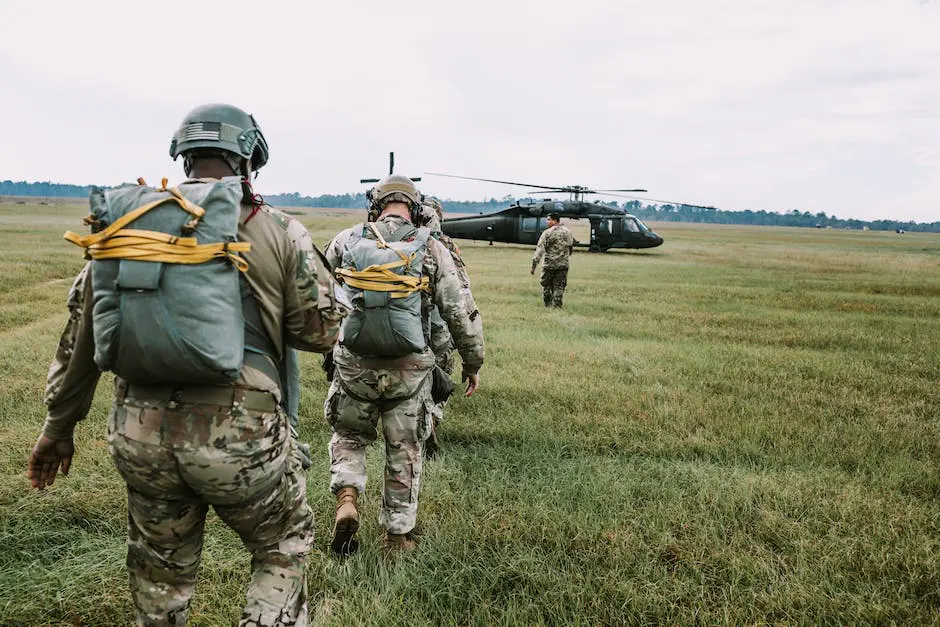The robust physical health and endurance capabilities of military personnel is no mystery but the culmination of rigorous discipline, strategic exercises, and planned nutrition. This examination will navigate through the intricate web of military fitness requirements, breaking down the different physical fitness tests implemented by various military branches, and elucidate their unique requirements. In tandem, we will delve into the art of curating an optimal fitness regimen that amalgamates strength and endurance, complemented by a focused understanding of the critical role of nutrition in augmenting physical performance. Furthermore, an often neglected yet crucial aspect of fitness, recovery, and injury prevention will be underscored, illustrating how these elements can enhance performance and longevity in military physical fitness.
Understanding Military Fitness Requirements
Understanding Army Physical Fitness Requirements
The Army Physical Fitness Test (APFT) consists of three events: Pushups, Sit-ups and the 2-mile run. In each event, scoring depends on the person’s age and gender. For instance, adults aged 17-21 must do a minimum of 35 pushups, 47 sit-ups and complete the 2-mile run in 16:36 mins to pass. Good preparation techniques include consistent cardio exercises for endurance and bodyweight exercises for strength.
Navy Fitness Standards
The Navy Physical Readiness Test (PRT) includes Push-ups, Sit-ups and a 1.5-mile run. The minimum requirements for a male aged 20-24 are 42 push-ups, 50 sit-ups and a 1.5-mile run in 13:30 mins. A female aged 20-24 needs 19 push-ups, 50 sit-ups and the 1.5-mile run in 15:15 mins. For cardio exercises, interval training works well, and the recommended strength training exercises include squats, lunges, and planks.
Air Force Fitness Requirements
The Air Force Physical Fitness Test (PFT) comprises Push-ups, Sit-ups, a 1.5-mile run and a waist circumference measurement. For males aged 30-39, the minimum requirements are 33 push-ups, 42 sit-ups, a run time of 14:26 mins, and a waist circumference of no more than 39 inches. Females in the same age bracket require 18 push-ups, 38 sit-ups, a run time of 16:22 mins, and a waist circumference not more than 35.5 inches. Preparation involves core strengthening exercises and cardio to improve overall endurance.
Understanding Marine Corps Fitness Standards
The Marine Corps Physical Fitness Test (PFT) includes Pull-ups (or Push-ups), Crunches (or Plank Pose) and a 3-mile run. Men aged 17-26 need a minimum of 4 pull-ups, 70 crunches in 2 minutes, and a 3-mile run in 28 minutes. The minimum for women of the same age range is 15 push-ups, 50 crunches in 2 minutes, and a 3-mile run in 31 minutes. Improving physical fitness for the Marine Corps Fitness Test often requires weightlifting, interval running, and proper nutrition.
Coast Guard Fitness Standards
In the U.S. Coast Guard’s Physical Fitness Assessment (PFA), members are tested in a 1.5-mile run, Push-ups, Sit-ups, and either a Swim test or Complete the Prone Float for 5 minutes. Males aged 30-39 have to complete a minimum of 29 push-ups, 38 sit-ups, and the run in 14:08 mins. The equivalent standards for females in this age group are 15 push-ups, 32 sit-ups, and a run time of 17:00 mins. Increasing water confidence, improving cardiovascular fitness and regular strength training can help meet these standards.

Developing a Fitness Regimen
Understanding Military Fitness Requirements
Before starting any workout regimen, it’s necessary to understand the physical fitness expectations for military personnel. Every branch of the service — Air Force, Army, Navy, Marine Corps — has specific fitness requirements and tests focusing on strength, endurance, and flexibility. Understand the specifics of these tests to tailor a fitness program that meets and exceeds these standards.
Establishing a Schedule
Creating a consistent schedule is crucial when developing any fitness regimen. Aim for at least five aerobic workouts a week, each lasting 20 to 60 minutes. These might include running, cycling, or swimming. Additionally, incorporate three strength-building workouts per week, focusing on different muscle groups each session. Always allow for at least one or two days of rest per week to permit muscle tissue reconstruction.
Aerobic Workouts
Start the workout regimen with aerobic exercises, as they have been proven to prevent injuries and improve overall performance. Examples of aerobic exercises include running, swimming, or cycling. These exercises contribute to improving cardiovascular health, boosting endurance, and burning calories.
Running Exponentially
One of the best ways to build endurance is through running. It’s fundamental to several military fitness tests, so it should become a primary component of your workout regimen. Start by setting a realistic distance goal and gradually increase it each week.
Building Strength
Strength is critical as it aids in carrying heavy loads and performing physical tasks more efficiently. Workouts should vary between bodyweight exercises, such as pull-ups and push-ups, and weightlifting exercises to build muscle mass. Lifting weights also aids in injury prevention through the strengthening of joints, tendons, and ligaments. Be consistent in the strength workouts, aiming to increase repetitions or weight each week.
Mixed Training
Mixed training, also known as high-intensity interval training (HIIT), is an effective way to maximize physical fitness in a short amount of time. This could involve sprint intervals, Tabata workouts, or circuit training. Mixing high-intensity with moderate-intensity exercises during a workout helps to improve both strength and endurance.
Flexibility and Balance
Although it might be overlooked, flexibility is fundamental to military fitness as it aids in the prevention of injury. Enhancing flexibility can be accomplished through activities such as yoga or Pilates. Balance exercises, like those done on a stability ball, should also be included in the weekly exercise program.
Hydration and Nutrition
Lastl,y remember to prioritize good hydration and nutrition. Drink plenty of water before, during, and after exercises. Additionally, include carbohydrates in your diet for energy, and balance them with ample proteins for muscle recovery and building. Consuming a balance of nutrients not only supports the physical demands of training but also health in general.

Nutrition for Fitness Improvement
Understanding the Role of Nutrition in Improving Physical Performance
Your diet plays a critical role in optimizing physical performance and recovery from strenuous training or exercises. It’s important to consume sufficient quantities of macronutrients—proteins, carbohydrates, and fats—and micronutrients to enhance energy production, muscle building, and recovery.
Protein for Muscle Building and Recovery
Proteins are essential for rebuilding and repairing muscles after a strenuous workout. They also help in producing enzymes, hormones, and improving the immune system. Most fitness experts recommend active individuals or athletes require 1.2-2.0 grams of protein per kilogram of body weight daily. Protein-rich foods include poultry, lean meat, fish, eggs, dairy products, nuts, seeds, and legumes.
Carbohydrates for Energy Production
Carbohydrates are the body’s primary source of energy. They fuel your muscles before, during, and after a workout. Complex carbs—whole grain bread, cereals, pasta, rice, and fruits—should make up the bulk of your carb intake because they provide sustained, long-term energy and help maintaining stable blood sugar levels. It’s recommended that athletes get about 6-10 grams per kilogram of body weight daily.
Fats for Sustained Energy and Hormone Production
Healthy fats like monounsaturated and polyunsaturated fats provide sustained energy, assist in vitamin absorption, and are important for hormone production. Fats should make up 20-35% of your total daily caloric intake. Foods such as avocados, olive oil, nuts, seeds, and fish are good sources of healthy fats.
Hydration for Performance and Recovery
Water is crucial for your body’s temperature control, nutrient transportation, and overall bodily function. Dehydration can impair your physical performance and recovery. Drink about half a liter of water 2-3 hours before your workout, and continue to sip on water every 15-20 minutes during your workout.
Micronutrients for Optimal Body Function
Aside from the macronutrients, vitamins and minerals—micronutrients—play a crucial role in maintaining good health and optimizing performance. Iron, calcium, vitamin D, B-vitamin complex, and antioxidants are particularly important. A balanced diet rich in fruits, vegetables, lean proteins, and whole grains should provide all the essential micronutrients.
Meal Timing and Frequency
When you eat is just as important as what you eat. Regular meals and healthy snacks throughout the day maintain your glucose levels and metabolism. Eating a balanced meal or snack high in carbs and protein within 30 minutes post-exercise is crucial for recovery.
Remember, improving military physical fitness is not a one size fits all approach. Nutritional needs can vary based on individual goals, body type, and training. It’s wise to work with a nutritionist or dietitian who specializes in sports nutrition to create a tailored plan that fits your lifestyle and fitness objectives.

Recovery & Injury Prevention
Understanding the Importance of Recovery
In the military, physical fitness is vital. However, pushing too hard without adequate recovery and injury prevention methods can lead to detrimental effects on performance and longevity. It’s essential to understand that recovery is just as important as the workout itself. It is during this rest period that the body heals, rebuilds tissues, and becomes stronger.
The Role of Proper Rest
Ensure you get adequate sleep for complete body recovery, aiming for 7 to 9 hours each night. A lack of proper sleep can increase the risk of injury due to a lower pain threshold and slower reaction times. Listen to your body and remember that rest days are crucial for muscle growth and injury prevention.
Stretching for Injury Prevention
After physical exertion, incorporate a regime of stretching to help muscles return to their resting length, preventing stiffness and injury. Different types of stretches work best for different goals. For instance, dynamic stretching is ideal before a workout to prepare the body for movement, while static stretching after a workout can reduce stress on the muscles.
Incorporating Yoga in Routine
Yoga can be an effective tool for both recovery and injury prevention. The stretching components of yoga improve flexibility, which can prevent injuries. The breathing techniques practiced in yoga can also improve lung capacity and endurance. Yoga’s focus on mindfulness and mental well-being can also prove beneficial in managing stress and promoting a positive mindset.
Physiotherapy Exercises
Incorporating physiotherapy exercises into your routine can reduce the risk of injuries and improve physical fitness. These exercises, designed to strengthen muscles and improve flexibility, can be particularly beneficial in recovering from injuries. In fact, physiotherapy exercises are often used in rehabilitation programs for injured military personnel.
Preventing Injuries by Warming up and Cooling down
Warming up before any physical exertion prepares your body for the activity, helping to prevent injuries. Cooling down after workouts offer a transition period to bring your heart rate, body temperature, and breathing back to normal, reducing the risk of muscle stiffness and cardiac stress.
Using Proper Equipment
Another essential aspect of injury prevention is using proper equipment. Whether it’s wearing appropriate footwear to prevent ankle injuries or using the correct form while lifting weights, the appropriate gear and practices can significantly lower the risk of injury.
Regular Check-ups
Lastluy, regular check-ups can help identify potential issues before they become a significant problem. Similarly, if you feel any discomfort during or after your exercise, it’s crucial to consult with a healthcare provider to prevent any potential injuries from worsening.

As we have discovered, there is a lot more to military fitness than strength and endurance alone. The interconnected fabric of robust exercise routines, disciplined nutritional intakes, and focused recovery and injury prevention techniques are equally, if not more, essential. To amplify the effectiveness of your military fitness journey, it’s indispensable to comprehend the specificities and ethos behind the physical fitness benchmarks set by different military branches. Additionally, learning about the pivotal role of nutrition in energy supply, muscle growth and repair can dramatically enhance your overall fitness progress. Lastly, incorporating efficient recovery methods, as well as injury prevention strategies such as yoga or physiotherapy exercises, can significantly prolong your tenure in reaching and maintaining optimal military physical fitness standards.

